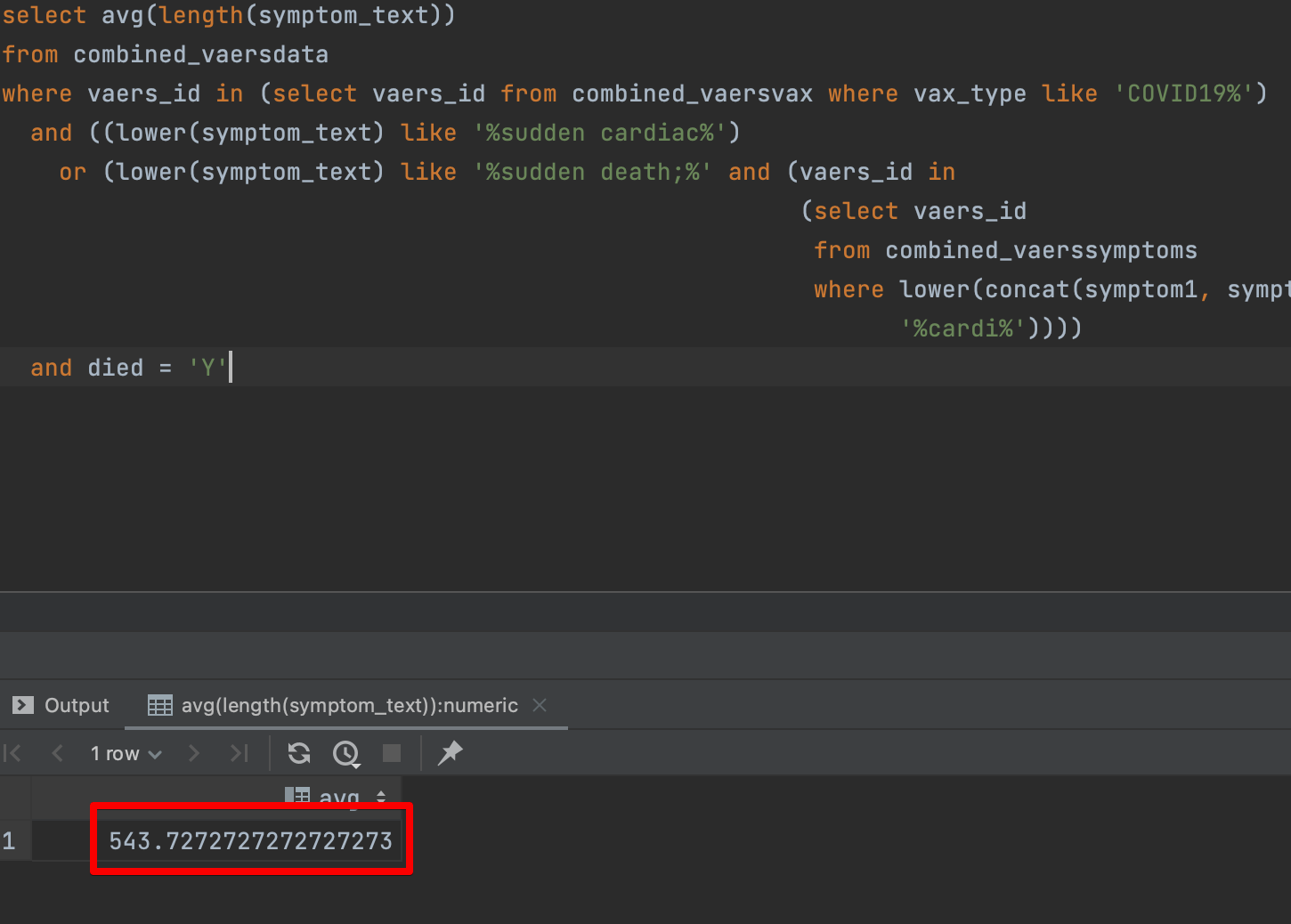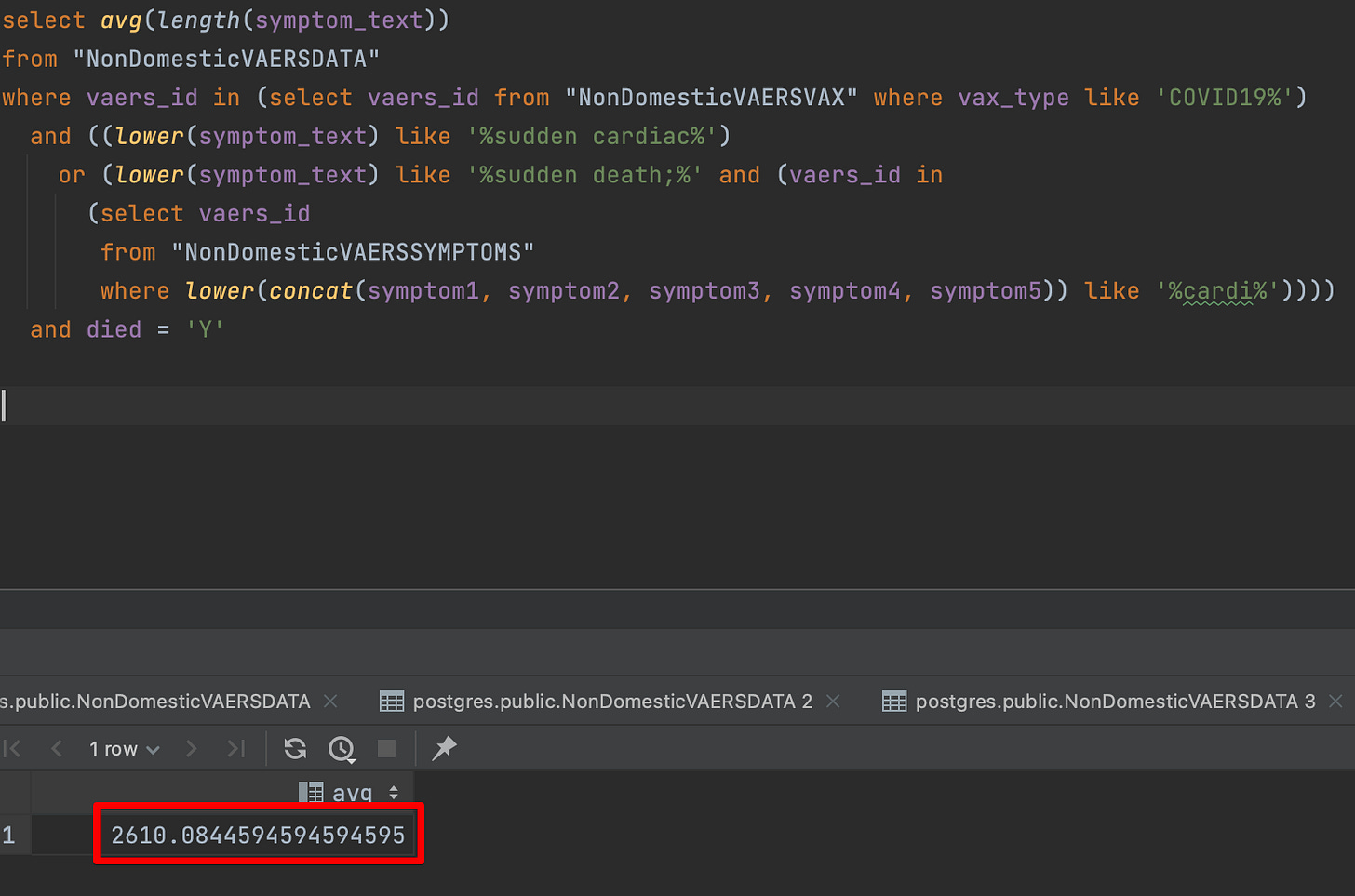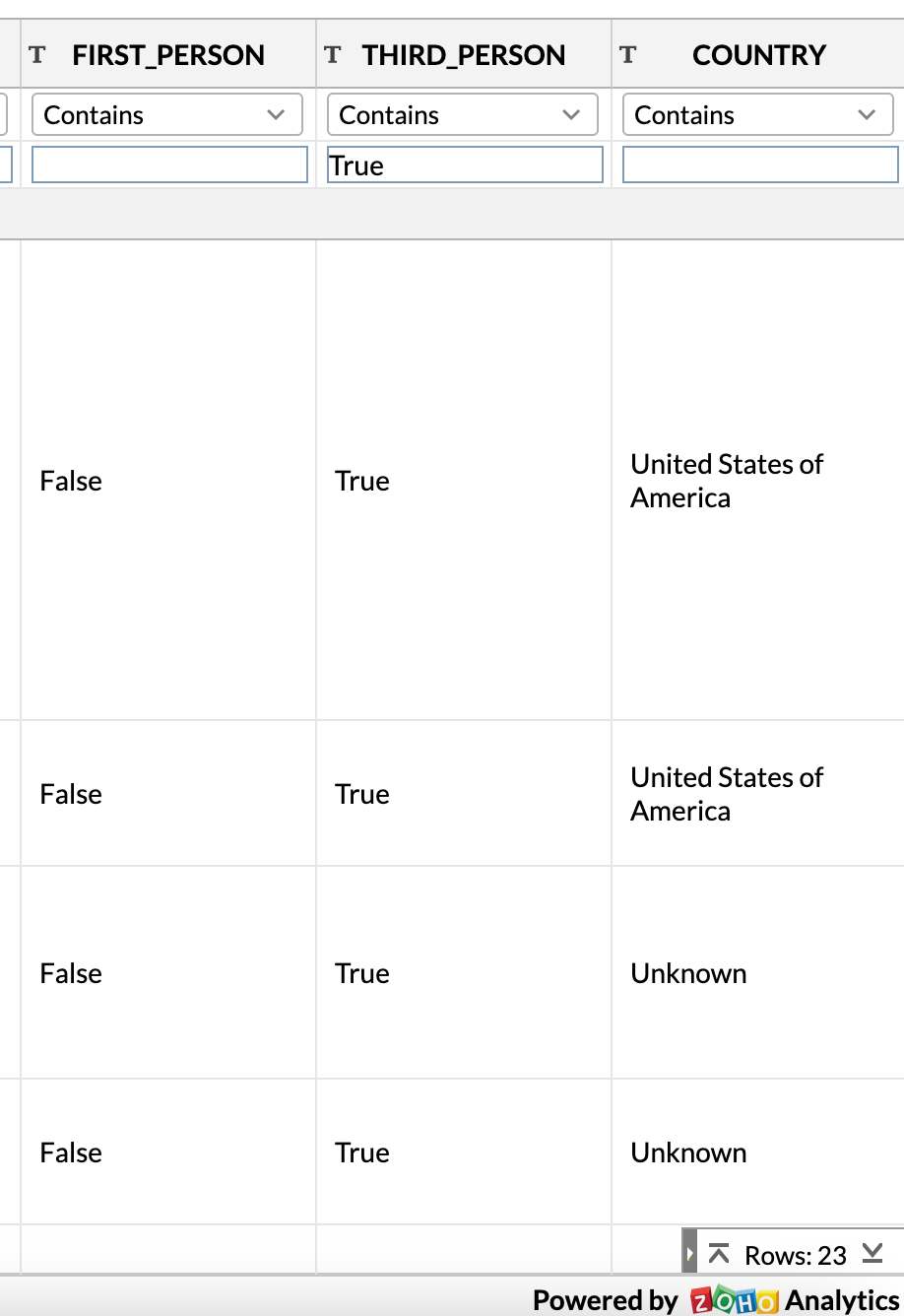Key takeaways:
data scientists can construct a simple SQL query to find sudden cardiac death reports in VAERS
there are about 300 sudden death reports in foreign VAERS and over 50 sudden death reports in US VAERS, and the foreign VAERS reports are qualitatively much better than US VAERS reports
there is a loophole in the US VAERS system which allows some sudden deaths to fall through the cracks and not even be reported
Recently, I saw this tweet:
This is one of the most preposterous tweets I have read (in fact that entire Twitter thread is misleading), and I started wondering how someone could have such a poor understanding of VAERS.
The problem, I think, is that Daniel never looked at foreign VAERS reports1.
As you can see the claim here is that he saw no “true” sudden death reports.
In reality, it is very easy to find them, if you have basic data science skills2. And I will also explain how to do it.
Note: Update based on the comments I have received
Many comments have pointed out that my number is only a lower bound, and I agree. I used the simplest possible way I could think of to find sudden cardiac deaths.
But the main point of my article is
a) to show that it is fairly easy to find hundreds of such reports
b) to show that if you don’t have access to the writeup to cross verify the translated fields, this analysis becomes much harder. The CDC stopped publishing VAERS writeups for EU in Nov 2022. This means you will get an extremely distorted picture of VAERS deaths if you used just the CDC Wonder tool, like Daniel did.
A simple SQL query to fetch sudden death VAERS reports
I was able to fetch nearly 300 sudden death reports from the foreign VAERS dataset by using this simple SQL query:
It is once again a good time to remind folks that I am using the last good copy of the foreign VAERS dataset from November 2022, because after that the CDC decided to stop publishing the write-ups for all these reports.
If I used the latest copy of the CSV files, I would be missing the majority of these because EU reports would have not returned any results.
Also, the reason I am using “sudden death;” is because the semicolon at the end ensures that it is in the list of symptoms which is often provided in the beginning of the writeup.
If I omit the semicolon, I get a lot of false positive matches which sometimes matches things like ‘there is no history of sudden death in his family’.
In other words, by doing nothing more than importing the CSV datasets into a tool like JetBrains DataGrip I was immediately able to find an initial set of 296 death reports which are clearly describing sudden death.
How many such sudden death reports can we find in the US dataset3?
Only 66
How descriptive are the two datasets?
The foreign and US datasets are not just quantitatively different, but they are also qualitatively different.
For example, let us compare how descriptive the two datasets are.
Let us calculate the mean length of the SYMPTOM_TEXT fields for the two datasets.
The US reports average only 543 characters.
On the other hand, the foreign reports average 2610 characters, which represents nearly 5 times the amount of information in the writeup.
It gets even more interesting if we filter for reports which are at least 500 characters long. All the 296 foreign reports (100%) clear that bar.
On the other hand, only 13 of the 66 (~20%) US reports have more than 500 characters in the writeup.
This disparity is probably due to the fact that a large majority of foreign VAERS reports are submitted by healthcare professionals, while a large majority of US VAERS reports are submitted by non HCPs.
And this disparity might also explain why Daniel thought most of the sudden death reports were fake ones sent in by “anti-vaxxers” - they are not being filled out by professionals who are trying to be as thorough as possible, but probably by laypeople in emotional distress who can barely complete the VAERS online form4.
There is also a second, much more problematic reason which could explain the lack of sudden death reports in US VAERS.
The US VAERS system sometimes lets these sudden deaths fall through the cracks5, as we learnt in Victor Simoes’ story.
And even if you give the CDC the benefit of the doubt over followup reports, there is still a big loophole that no one seems to even know about - if someone dies suddenly, like it happened for Victor, there are no records at any hospital and nothing gets sent to the CDC.
If you had to choose one anecdote to show to people who are pro-mRNA vaccines
Steve Kirsch shared the story of Victor Simoes on Twitter recently If you read the full story, you will find out that Victor actually was working as a Senior Manager at Amazon. To point out that Victor had immense potential would be understating the case quite a bit.
How many of the sudden death reports are “true”?
I want to distinguish between “true” death reports and death reports which prove any kind of causation.
Obviously, the latter is very hard to prove using VAERS - in fact the anti-VAERS community will never stop reminding you of this.
But at least the Doctors in one country have been willing to go on record even within the VAERS report itself that the mRNA vaccine has indeed caused deaths.
Analyzing Japan VAERS death reports
Key takeaways: Japan is probably the only country where healthcare professionals are willing to go on record in the VAERS writeup that a death was actually related to the mRNA vaccine There are three levels of certainty within the reports - related, probably related and possibly related
For the purposes of this discussion, we will say that a sudden death report is true if it was filed by a healthcare professional6.
So by my definition a “true” report is when the adverse event definitely happened, but we may not know for sure if it was caused by the vaccine.
How many true sudden death reports are there in VAERS?
We will just do a simple filter for IS_HCP = ‘Yes’ for the foreign VAERS sudden death reports.
Out of the 266 foreign VAERS reports, I could identify that a healthcare professional sent in the report for 199 of them (67%).
In contrast, exactly ONE of the 66 (1.5%) US sudden death reports was sent in by an identifiable healthcare professional.
You can extend this a bit further by looking for third person reports. Most of the time, third person reports are filled out by people who are familiar with the VAERS system, but may not necessarily be a healthcare professional.
295 of the 296 foreign sudden death reports were filled out in third person.
On the other hand, only 23 of the 66 sudden death US reports were filled in by a third person.
In fact, if Daniel has never used anything except the CDC Wonder tool for his VAERS analysis, it is possible he does not even know about foreign VAERS reports, and how badly this lack of knowledge distorts the overall analysis. In a future article, I will explain why it is a bad idea to use the CDC Wonder tool for any kind of VAERS analysis
I will keep coming back to this theme. It is the basic premise of this entire Substack.
The dataset was last downloaded in May 2023
Apparently the online VAERS form times out every few minutes, forcing people to finish it as quickly as possible. This might disincentivize people from filling out long comments.
I know this seems like a very euphemistic way to put it, but I personally don’t know how much of this was intentional and how much was just a criminal level of negligence
Does this mean reports filed by non-healthcare professionals are false? I don’t think so. In fact, the folks at React19 did an independent audit which suggests that the VAERS reports are now heavily vetted. But testing if the report was filed by a healthcare professional provides additional rigor.

















I think these are sudden: https://imgur.com/gallery/8XQEK4F
Maybe these: https://www.vaersaware.com/3-hour-deaths
It's ~2100 sudden deaths, not ~350 (Aravind) or ~1300 (Eagle).
http://univaers.com/other/vaers_sudden_death_2023-06-30.csv
I'm using the flat file which retains the gigabyte of purged data and also notes text changes.
That is here:
https://deepdots.substack.com/p/new-vaers-flat-file-easy-data-mining
I'm also catching not only sudden cardiac or sudden death but things like ... suddenly died plus died suddenly and the word sudden within 20 characters of died or death whether in front or behind those words.
You can see that here with the first 20 from 'text_columns':
https://regex101.com/r/nOGr9b/1
Your job now is to see how many of mine are false positives. For example, the one that says this in the 'text_columns' column (a concat of them excluding HISTORY) is a false positive:
"fear of death; suddenly rising blood"
It's 2,571 using regex (?:sudden|unexpect) ... sudden OR unexpect as root, like unexpectedly died.